1996 CHEVROLET TAHOE wheel
[x] Cancel search: wheelPage 197 of 403
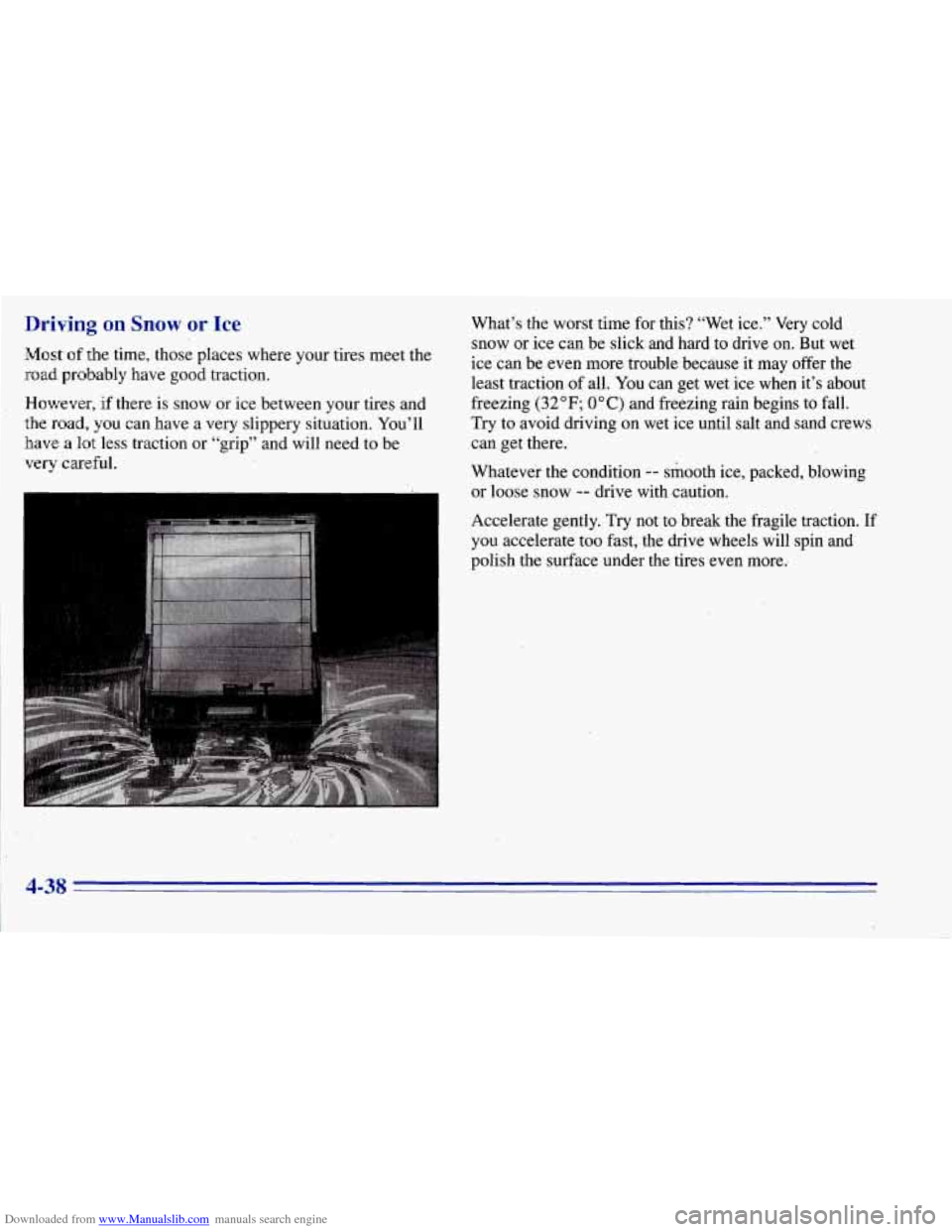
Downloaded from www.Manualslib.com manuals search engine Driving on Snow or Ice
Most of the time, those places where your tires meet the
road probably have good traction.
However, if there is snow or ice between your tires and
the
mad, you can have a very slippery situation. You’ll
have .a lot l’ess traction or’ “grip” and will need to be
very
c ueful .
What’s the worst time for this? “Wet ice.” Very cold
snow or ice can be slick and hard
to drive on. But wet
ice can be even more trouble because it may offer the least traction
of all. You can get wet ice when it’s about
freezing
(32 OF; 0 O C) and freezing rain begins to fall.
Try to avoid driving on wet ice until salt and sand crews
can get there.
Whatever the condition
-- smooth ice, packed, blowing
or loose snow -- drive with caution.
Accelerate gently. Try not to break the fragile traction. If
you accelerate too fast, the drive wheels will spin and
polish the surface under the tires even more..
4-38
Page 209 of 403
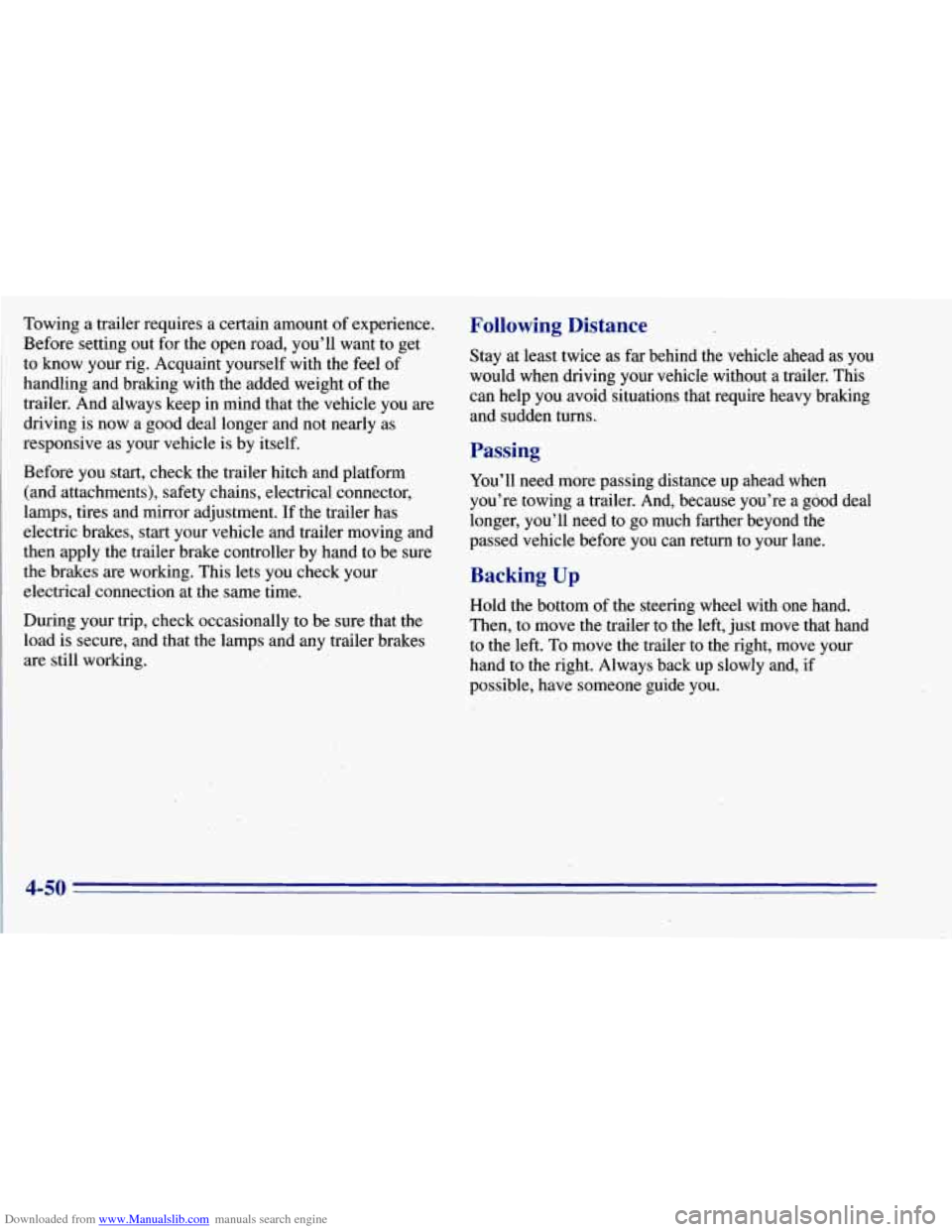
Downloaded from www.Manualslib.com manuals search engine Towing a trailer requires a certain amount of experience. Before setting out for the open road, you’ll want to get
to know.your rig. Acquaint yourself with the feel of
handling and br’aking with the,added weight of the
trailer. ‘And always keep in mind that the vehicle you are
driving
is now a good deal longer and not nearly as
responsive as your vehicle is by itself.
Before you start, check the trailer hitch- and platform (and attachments), safety chains, electrical connector,
lamps, tires and mirror adjustment. If the trailer has
electric brakes, start your vehicle and trailer moving and
then apply the trailer brake controller by hand to be sure
the brakes are working. This lets
you check your
electrical-connection
at the same time.
During your trip, check occasionally to be sure that the
load is secure, and that the lamps and any trailer brakes are still working.
Following Distance
Stay at least twice as far behind the vehicle ahead as you
would when driving your vehicle without
a trailer. This
can help you avoid situations that require heavy braking
.l
and sudden turns.
Passing
You’ll need more passing distance up ahead when you’re towing a trailer. And, because you’re a good dea
longer, you’ll need to go much farther beyond the
passed vehicle before you can return to your lane.
Backing Up
Hold the bottom of the steering wheel with one hand.
Then, to move the trailer to the left, just move that hand
to the left. To move the trailer to the right, move your
hand to the right. Always back up slowly and, if
possible, have someone guide you.
4-50
Page 211 of 403

Downloaded from www.Manualslib.com manuals search engine Parking on Hills
You really should not park your vehicle, with a trailer
attached, on a hill. If something goes wrong, your rig
could start to move. People can be injured, and both
your vehicle and the trailer can be damaged.
But if you ever have to park your rig on a hill, here’s
1 how to do it:
1.
2.
3.
4.
5.
6.
Apply your regular brakes, but don’t shift into
PARK
(P) yet.
Have someone place chocks under the trailer wheels.
When the wheel chocks are in place, release the
regular brakes until the chocks absorb the load.
Reapply the regular brakes. Then apply your parking
brake, and then shift to PARK (P).
If you have a four-wheel-drive vehicle, be sure
the transfer case is in a drive gear
-- not in
NEUTRAL
(N).
Release the regular brakes.
1
I A CAUTION:
It can be dangerous to get out of your vehicle if
the shift lever
is not fully in PARK (P) with the
parking brake firmly set. Your vehicle can roll.
If you have left the engine running, the vehicle
can move suddenly. You or others could be
injured. To be sure your vehicle won’t move, even
when you’re on fairly level ground, use the steps
that follow.
If you have four-wheel drive and your transfer
case is in NEUTRAL
(N), your vehicle will be free
to roll, even if your shift lever is in
PARK (P). So,
be sure the transfer case is in a drive gear -’- not
in NEUTRAL
(N).
4-52
Page 213 of 403
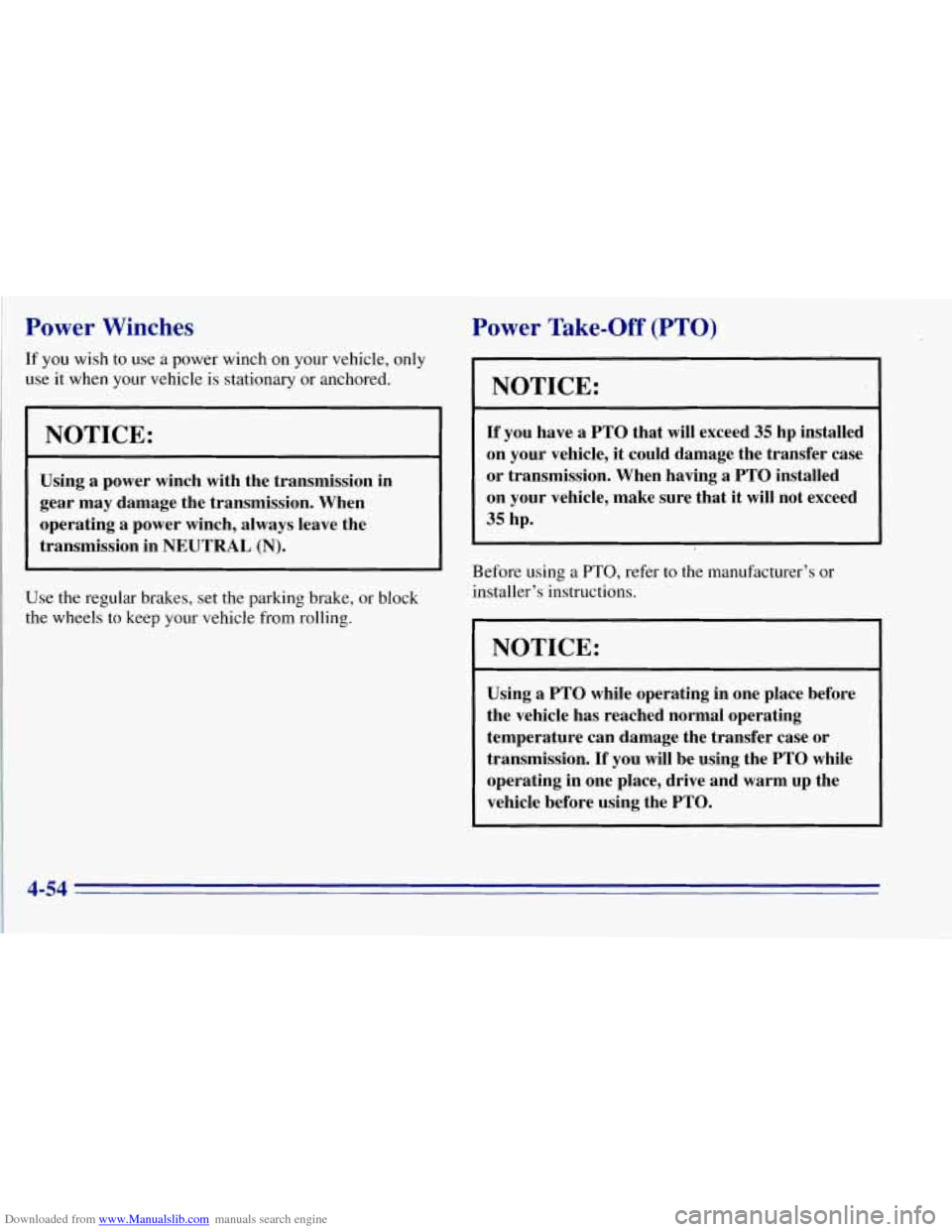
Downloaded from www.Manualslib.com manuals search engine Power Winches Power Take-Off (PTO)
If you wish to use a power winch on your vehicle, only
use it when your vehicle is stationary or anchored.
NOTICE:
Using a power winch with the transmission in
gear may damage the transmission. When
operating
a power winch, always leave the
transmission in NEUTRAL
(N).
Use the regular brakes, set the parking brake, or block
the wheels to keep your vehicle from rolling.
NOTICE:
If’ you have a PTO that will exceed 35 hp installed
on your vehicle,
it could damage the transfer case
or transmission. When having
a PTO installed
on your vehicle, make sure that
it will not exceed
35 hp.
Before using a PTO, refer to the manufacturer’s or
installer’s instructions.
NOTICE:
Using a PTO while operating in one place before
the vehicle has reached normal operating
temperature can damage the transfer case or
transmission. If you will be using the PTO while
operating in one place, drive and warm up the
vehicle before using the PTO.
4-54
Page 214 of 403

Downloaded from www.Manualslib.com manuals search engine To engage a PTO:
1. Set the parking brake.
2. Shift the transmission into NEUTRAL (N).
3. Hold the clutch pedal down and engage the PTO.
NOTICE:
Using a PTO for more than four hours without
driving your vehicle can damage the transfer case
or transmission. If using a PTO for more than
four hours without driving your vehicle, drive
your vehicle for a while
to allow the transfer case
and transmission to
cool.
If you are going to drive the vehicle, shift the
transmission into the,gear
you want. Then shift the
transfer case into the range
you want (if you have
four-wheel drive), apply the regular brakes and
release the parking brake.
4. Release the clutch (and the regular brakes) as you
normally would. When you release the clutch, the
PTO will start.
Using a Transfer Case Mounted PTO
1. Set the parking brake.
2. Shift the transfer case into NEUTRAL (N).
3. Shift the transmission into NEUTRAL (N).
4. Engage the PTO.
If you are going to drive the vehicle, shift the
transfer case into the range
you want. Then apply the
regular brakes and release the parking brake.
5. Shift the transmission to THIRD (3) to start the PTO.
6. Release the regular brakes to drive the vehicle.
4-55
Page 217 of 403
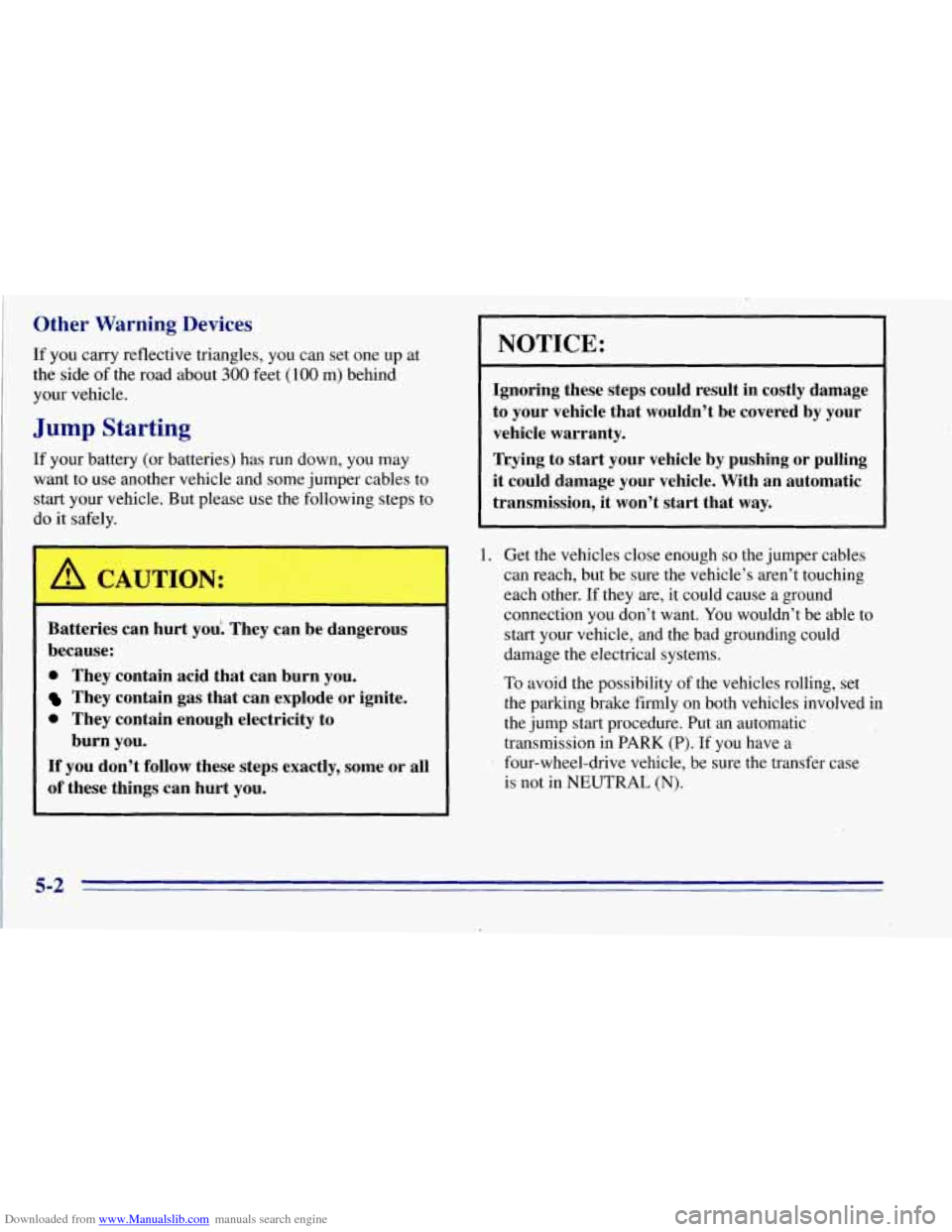
Downloaded from www.Manualslib.com manuals search engine Other Warning Devices
If you carry reflective triangles, you can set one up at .
the side of the road about 300 feet (100 m) behind
your vehicle.
Jump Starting
If your battery ,(or batteries) has run down, you may
want
to use another vehicle and some jumper cables to
start your vehicle. But please use the following steps to
do it safqly.
A CAUTION:
Batteries can hurt you! They can be dangerous
because:
0 They contain acid that can burn you.
They contain gas that can explode or ignite.
0 They contain enough electricity to
If you don’t follow these steps exactly, some or all
of these things can hurt you.
burn
you.
NOTICE:
Ignoring these steps could result in costly damage
to your vehicle that wouldn’t be covered by your
vehicle warranty.
Trying to start your vehicle by pushing or pulling
it could damage your vehicle. With an automatic
transmission,
it won’t start that way.
1. Get the vehicles close enough so the jumper cables
can reach, but be sure the vehicle’s aren’t touching
each other. If they are, it could cause a ground
connection you don’t want. You wouldn’t be able to
start your vehicle, and the bad grounding could
damage the electrical systems.
To avoid the possibility
of the vehicles rolling, set
the parking brake firmly on both vehicles involved in
the jump start procedure. Put an automatic
transmission in
PARK (P). If you have a
four-wheel-drive vehicle, be sure the transfer case
is not in NEUTRAL (N).
5-2
Page 221 of 403
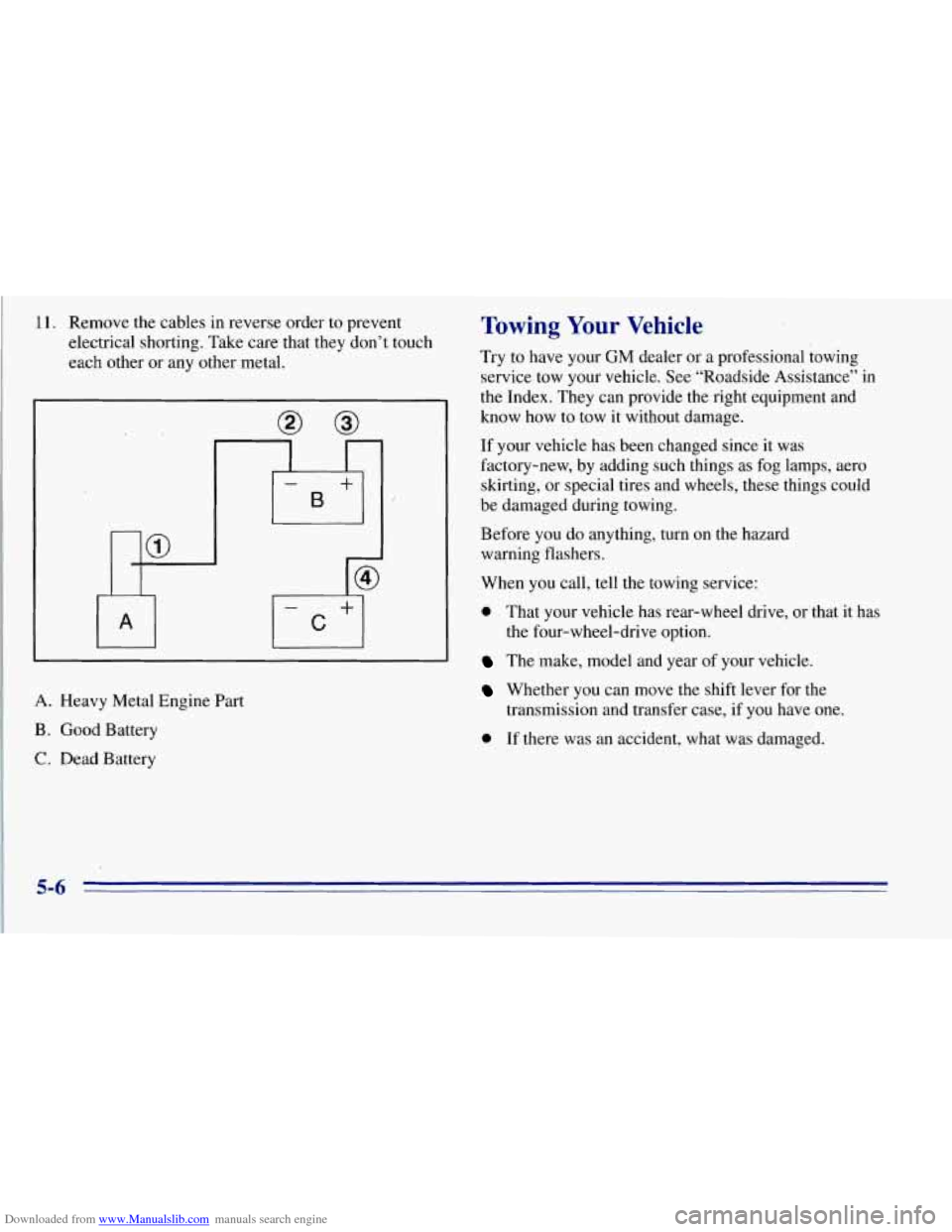
Downloaded from www.Manualslib.com manuals search engine 11. Remove the cables in reverse order to prevent
electrical shorting. Take care that they don’t touch
each other or any other metal.
-
-
A. Heavy Metal Engine Part
B. Good Battery
C. Dead Battery
5-6
Towing Your Vehicle
Try to have your GM dealer or a professional towing
service tow your vehicle. See “Roadside Assistance” in
the Index. They can provide the right equipment and
know how to tow it without damage.
If your vehicle has
been changed since it was
factory-new, by adding such things as fog lamps, aero
skirting, or special tires and wheels, these things could
be damaged during towing.
Before
you do anything, turn on the hazard
warning flashers.
When-you call, tell the towing service:
0 That your vehicle has rear-wheel drive, or that it has
The make, model and year of your vehicle.
Whether you can move the shift lever for the
the four-wheel-drive option.
transmission and transfer case,
if you have one.
0 If there was an accident, what was damaged.
Page 222 of 403
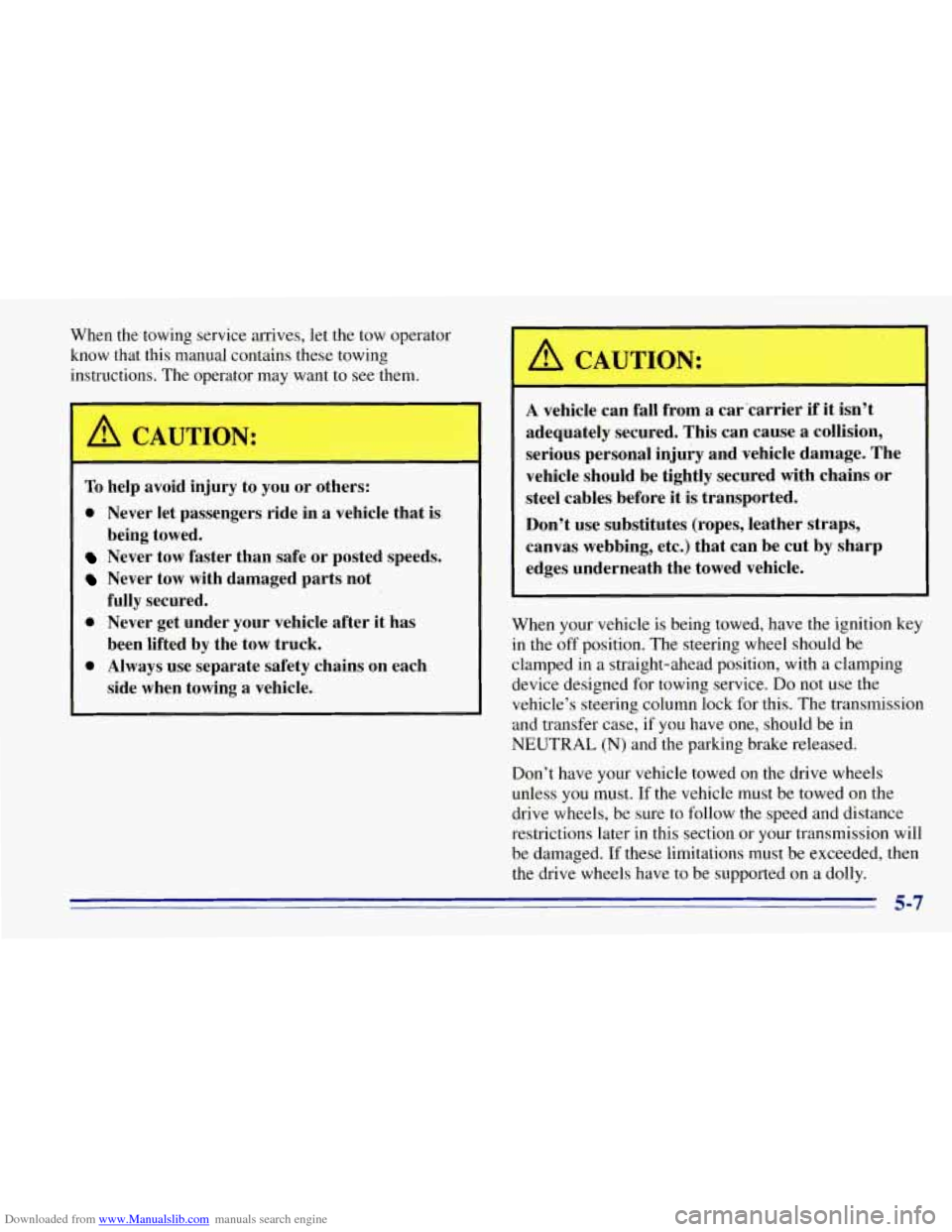
Downloaded from www.Manualslib.com manuals search engine When the towing service arrives, let the tow operator
know that this manual contains these towing
instructions. The operator may want to
see them.
I
A CAUTIO! :
To help avoid injury to you or others:
0 Never let passengers ride in a vehicle that is
Never tow faster than safe or posted speeds.
Never tow with damaged parts not
0 Never get under your vehicle after it has
0 Always use separate safety chains on each
being towed.
fully secured.
been lifted
by the tow truck.
side when towing
a vehicle.
- I
A vehicle can fall from a car’carrier if it isn’t
adequately secured. This can cause
a collision,
serious personal injury and vehicle damage. The
vehicle should be tightly secured with chains or
steel cables before it is transported.
Don’t use substitutes (ropes, leather straps,
canvas webbing, etc.) that can be cut
by sharp
edges underneath the towed vehicle.
When your vehicle is being towed, have the ignition key
in the off position. The steering wheel should be
clamped in a straight-ahead position, with
a clamping
device designed for towing service.
Do not use the
vehicle’s steering column lock for this. The transmission
and transfer case, if
you have one, should be in
NEUTRAL (N) and the parking brake released.
Don’t have your vehicle towed on the drive wheels
unless you must. If the vehicle must be towed
on the
drive wheels, be sure to follow the speed and distance
restrictions later in this section or your transmission will
be damaged. If these limitations must be exceeded, then
the drive wheels have
to be supported on a dolly.
5-7